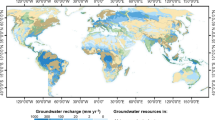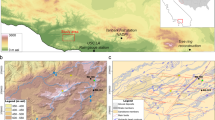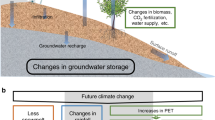Abstract
The depletion of groundwater resources threatens food and water security in India. However, the relative influence of groundwater pumping and climate variability on groundwater availability and storage remains unclear. Here we show from analyses of satellite and local well data spanning the past decade that long-term changes in monsoon precipitation are driving groundwater storage variability in most parts of India either directly by changing recharge or indirectly by changing abstraction. We find that groundwater storage has declined in northern India at the rate of 2 cm yr−1 and increased by 1 to 2 cm yr−1 in southern India between 2002 and 2013. We find that a large fraction of the total variability in groundwater storage in north-central and southern India can be explained by changes in precipitation. Groundwater storage variability in northwestern India can be explained predominantly by variability in abstraction for irrigation, which is in turn influenced by changes in precipitation. Declining precipitation in northern India is linked to Indian Ocean warming, suggesting a previously unrecognized teleconnection between ocean temperatures and groundwater storage.
This is a preview of subscription content, access via your institution
Access options
Access Nature and 54 other Nature Portfolio journals
Get Nature+, our best-value online-access subscription
$29.99 / 30 days
cancel any time
Subscribe to this journal
Receive 12 print issues and online access
$259.00 per year
only $21.58 per issue
Buy this article
- Purchase on Springer Link
- Instant access to full article PDF
Prices may be subject to local taxes which are calculated during checkout





Similar content being viewed by others
References
Tiwari, V. M., Wahr, J. & Swenson, S. Dwindling groundwater resources in northern India, from satellite gravity observations. Geophys. Res. Lett. 36, L18401 (2009).
Rodell, M., Velicogna, I. & Famiglietti, J. S. Satellite-based estimates of groundwater depletion in India. Nature 460, 999–1002 (2009).
Wada, Y., van Beek, L. P. H. & Bierkens, M. F. P. Nonsustainable groundwater sustaining irrigation: a global assessment. Wat. Resour. Res. 48, W00L06 (2012).
Döll, P. & Siebert, S. Global modeling of irrigation water requirements. Wat. Resour. Res. 38, 8–1–8–10 (2002).
Scanlon, B. R. et al. Groundwater depletion and sustainability of irrigation in the US high plains and central valley. Proc. Natl Acad. Sci. USA 109, 9320–9325 (2012).
Taylor, R. G. et al. Evidence of the dependence of groundwater resources on extreme rainfall in East Africa. Nat. Clim. Change 3, 374–378 (2013).
Gandhi, V. P. et al. Groundwater Irrigation in India: Gains, Costs, and Risks (Indian Institute of Management Ahmedabad, 2009).
Shah, T. Climate change and groundwater: India’s opportunities for mitigation and adaptation. Environ. Res. Lett. 4, 035005 (2009).
Siebert, S. et al. Groundwater use for irrigation—a global inventory. Hydrol. Earth Syst. Sci. 14, 1863–1880 (2010).
Mishra, V., Smoliak, B. V., Lettenmaier, D. P. & Wallace, J. M. A prominent pattern of year-to-year variability in Indian summer monsoon rainfall. Proc. Natl Acad. Sci. USA 109, 7213–7217 (2012).
Bollasina, M. A., Ming, Y. & Ramaswamy, V. Anthropogenic aerosols and the weakening of the South Asian summer monsoon. Science 334, 502–505 (2011).
Roxy, M. K. et al. Drying of Indian subcontinent by rapid Indian Ocean warming and a weakening land–sea thermal gradient. Nat. Commun. 6, 7423 (2015).
Mishra, V., Shah, R. & Thrasher, B. Soil moisture droughts under the retrospective and projected climate in India. J. Hydrometeorol. 15, 2267–2292 (2014).
Wada, Y., Wisser, D. & Bierkens, M. F. P. Global modeling of withdrawal, allocation and consumptive use of surface water and groundwater resources. Earth Syst. Dyn. 5, 15–40 (2014).
Whittemore, D. O., Butler, J. J. Jr & Wilson, B. B. Assessing the major drivers of water-level declines: new insights into the future of heavily stressed aquifers. Hydrol. Sci. J. 61, 134–145 (2016).
Yue, S. & Wang, C. Y. Regional streamflow trend detection with consideration of both temporal and spatial correlation. Int. J. Climatol. 22, 933–946 (2002).
Report of the Ground Water Estimation Committee: Ground Water Resource Estimation Methodology (Ministry of Water Resources, Government of India, 2009).
MacDonald, A. M. et al. Groundwater Resources in the Indo-Gangetic Basin: Resilience to Climate Change and Abstraction OR/15/047 (British Geological Survey, 2015).
Basharat, M., Hassan, D., Bajkani, A. A. & Sultan, S. J. Surface Water and Groundwater Nexus: Groundwater Management Options for Indus Basin Irrigation System (International Waterlogging and Salinity Research Institute (IWASRI), Water and Power Development Authority, Publication 299, 2014).
MacDonald, A. M. et al. Groundwater quality and depletion in the Indo-Gangetic Basin mapped from in situ observations. Nat. Geosci. 9, 762–766 (2016).
Schaner, N., Voisin, N., Nijssen, B. & Lettenmaier, D. P. The contribution of glacier melt to streamflow. Environ. Res. Lett. 7, 034029 (2012).
Immerzeel, W. W., Van Beek, L. P. & Bierkens, M. F. Climate change will affect the Asian water towers. Science 328, 1382–1385 (2010).
Harvey, F. E. & Sibray, S. S. Delineating ground water recharge from leaking irrigation canals using water chemistry and isotopes. Ground Water 39, 408–421 (2001).
Azen, R. & Budescu, D. V. The dominance analysis approach for comparing predictors in multiple regression. Psychol. Methods 8, 129–148 (2003).
Roxy, M. K., Ritika, K., Terray, P. & Masson, S. The curious case of Indian Ocean warming. J. Clim. 27, 8501–8509 (2014).
Kumar, K. K., Rajagopalan, B., Hoerling, M., Bates, G. & Cane, M. Unraveling the mystery of Indian monsoon failure during El Niño. Science 314, 115–119 (2006).
Shah, H. L. & Mishra, V. Hydrologic changes in Indian sub-continental river basins (1901–2012). J. Hydrometeorol. 17, 2667–2687 (2016).
Ashok, K., Guan, Z., Saji, N. H. & Yamagata, T. Individual and combined influences of ENSO and the Indian Ocean dipole on the Indian summer monsoon. J. Clim. 17, 3141–3155 (2004).
Compo, G. P. & Sardeshmukh, P. D. Removing ENSO-related variations from the climate record. J. Clim. 23, 1957–1978 (2010).
Taylor, R. G. et al. Ground water and climate change. Nat. Clim. Change 3, 322–329 (2013).
Fishman, R. M., Siegfried, T., Raj, P., Modi, V. & Lall, U. Over-extraction from shallow bedrock versus deep alluvial aquifers: reliability versus sustainability considerations for India’s groundwater irrigation. Wat. Resour. Res. 47, W00L05 (2011).
Döll, P. Vulnerability to the impact of climate change on renewable groundwater resources: a global-scale assessment. Environ. Res. Lett. 4, 035006 (2009).
Raza, A., Latif, M. & Shakir, A. S. Long-term effectiveness of lining tertiary canals in the Indus basin of Pakistan. Irrig. Drain. 62, 16–24 (2013).
Shamsudduha, M., Taylor, R. G., Ahmed, K. M. & Zahid, A. The impact of intensive groundwater abstraction on recharge to a shallow regional aquifer system: evidence from Bangladesh. Hydrogeol. J. 19, 901–916 (2011).
Wada, Y. et al. Global depletion of groundwater resources. Geophys. Res. Lett. 37, L20402 (2010).
Pai, D. S. et al. Development of a new high spatial resolution (0.25° × 0.25°) long period (1901–2010) daily gridded rainfall data set over India and its comparison with existing data sets over the region. MAUSAM 65, 1–18 (2014).
Landerer, F. W. & Swenson, S. C. Accuracy of scaled GRACE terrestrial water storage estimates. Wat. Resour. Res. 48, W04531 (2012).
Swenson, S. & Wahr, J. Post-processing removal of correlated errors in GRACE data. Geophys. Res. Lett. 33, L08402 (2006).
Rodell, M. et al. The global land data assimilation system. Bull. Am. Meteorol. Soc. 85, 381–394 (2004).
Huffman, G. J. et al. The TRMM multisatellite precipitation analysis (TMPA): quasi-global, multiyear, combined-sensor precipitation estimates at fine scales. J. Hydrometeorol. 8, 38–55 (2007).
Siebert, S., Döll, P., Feick, S., Hoogeveen, J. & Frenken, K. Global Map of Irrigation Areas (Version, 2007).
Aquifer Systems of India (Central Ground Water Board, Ministry of Water Resources, Government of India, 2012).
Dorigo, W. et al. Evaluating global trends (1988–2010) in harmonized multi-satellite surface soil moisture. Geophys. Res. Lett. 39, L18405 (2012).
Mu, Q., Heinsch, F. A., Zhao, M. & Running, S. W. Development of a global evapotranspiration algorithm based on MODIS and global meteorology data. Remote Sens. Environ. 111, 519–536 (2007).
Mann, H. B. Nonparametric tests against trend. Econ. J. Econ. Soc. 13, 245–259 (1945).
Sen, P. K. Estimates of the regression coefficient based on Kendall’s tau. J. Am. Stat. Assoc. 63, 1379–1389 (1968).
McKee, T. B., Doesken, N. J. & Kleist, J. The relationship of drought frequency and duration to time scales. Proc. 8th Conf. Appl. Clim. Vol. 17, 179–183 (American Meteorological Society, 1993).
Budescu, D. V. Dominance analysis: a new approach to the problem of relative importance of predictors in multiple regression. Psychol. Bull. 114, 542–551 (1993).
Nimon, K. F. & Oswald, F. L. Understanding the results of multiple linear regression beyond standardized regression coefficients. Organ. Res. Methods 16, 650–674 (2013).
Smith, T. M., Reynolds, R. W., Peterson, T. C. & Lawrimore, J. Improvements to NOAA’s historical merged land-ocean surface temperature analysis (1880–2006). J. Clim. 21, 2283–2296 (2008).
Acknowledgements
The authors acknowledge funding from the ITRA-Water project. Data availability from the Central Ground Water Board (CGWB), Gravity Recovery and Climate Experiment (GRACE), and India Meteorological Department (IMD) is greatly appreciated.
Author information
Authors and Affiliations
Contributions
V.M. conceived the idea. A.A. collected, analysed the data and developed the methodology. T.G. and Y.W. contributed to discussions of the findings. Y.W. provided groundwater recharge and abstraction data from the PCR-GLOBWB model. V.M. and A.A. wrote the manuscript with contributions from T.G. and Y.W.
Corresponding author
Ethics declarations
Competing interests
The authors declare no competing financial interests.
Supplementary information
Supplementary Information
Supplementary Information (PDF 3823 kb)
Rights and permissions
About this article
Cite this article
Asoka, A., Gleeson, T., Wada, Y. et al. Relative contribution of monsoon precipitation and pumping to changes in groundwater storage in India. Nature Geosci 10, 109–117 (2017). https://doi.org/10.1038/ngeo2869
Received:
Accepted:
Published:
Issue Date:
DOI: https://doi.org/10.1038/ngeo2869
This article is cited by
-
Global high-resolution total water storage anomalies from self-supervised data assimilation using deep learning algorithms
Nature Water (2024)
-
Drought Atlas of India, 1901–2020
Scientific Data (2024)
-
Indian interstate trade exacerbates nutrient pollution in food production hubs
Communications Earth & Environment (2024)
-
Piezometric depth modeling of groundwater using monthly variables of precipitation and water consumption (case study: Sarab Plain aquifer)
Discover Water (2024)
-
Bridging the Temporal Gaps in GRACE/GRACE–FO Terrestrial Water Storage Anomalies over the Major Indian River Basins Using Deep Learning
Natural Resources Research (2024)



